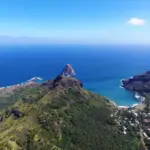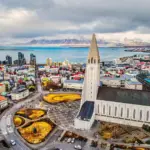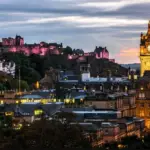
An Encounter with Beauty and History Painted in Celestial Hues
Introduction
The blue city Morocco is a hidden gem in the Rif Mountains in the northwest of the country. Also known as Chefchaouen, this charming city is famous for its narrow streets and facades painted in vibrant shades of blue. The surreal beauty of the Blue City attracts visitors from all over the world seeking a unique and photogenic experience.
Presentation of the Blue City of Morocco
Located about 600 kilometers north of Marrakech, the Blue City is a true hidden treasure in the North African country. Its name derives from the dazzling and iconic profusion of blue that envelops every street, wall, and building in the city. It's as if a magical sea spills over the hills and valleys, covering everything with its magnificent hue.

explanation of the origin and history of the city
The origins of the Blue City date back to the 15th century, when it was founded by Berbers seeking to escape Spanish rule in the region. The choice of the color blue is associated with both the Berber cultural tradition and the Jewish influence in the area.
According to Jewish tradition, blue represents protection against the evil eye and wards off evil spirits. Over the centuries, Chefchaouen has experienced several foreign invasions and occupations, including periods of Arab and Andalusian influence.
These events historical figures contributed to the cultural richness and architectural style of the city, which blends Islamic and European elements into its unique aesthetic. Now that we have a solid introduction to Morocco's Blue City, we can delve even deeper into its charms and peculiarities in the next section of this article.

Geographic location and climate
The Blue City of Morocco, also known as Chefchaouen, is located in the northwest of the country, nestled in the Rif Mountains. Located about 110 kilometers south of the coastal city of Tangier, it is strategically positioned in a picturesque mountainous area. The city is blessed with stunning views of the surrounding mountains and enjoys a mild climate throughout most of the year.
The city's altitude contributes to its pleasant climate. During the summer months, temperatures range between 25°C and 30°C, providing a welcome respite from the scorching heat of Morocco's coastal areas.
In the coldest winter months, temperatures can drop to around 10°C or even below. Visitors are fortunate to experience all four distinct seasons in Chefchaouen.
The city's location also contributes to its mystical and secluded atmosphere. Surrounded by majestic mountains and stunning natural landscapes, Chefchaouen is a true haven for those seeking an escape from the hustle and bustle of big cities.
Distinctive architectural features of the city
One of the most striking features of the Blue City is its buildings painted in vibrant shades of cerulean blue. Houses, walls, doors, and even staircases are carefully painted this iconic color, creating a magical and enchanting atmosphere. This practice is believed to have begun centuries ago to ward off mosquitoes and also to reflect the heat of the region's scorching sun.
Besides the predominant blue hue, Chefchaouen's architecture also displays Moorish and Andalusian influences. The buildings are adorned with intricate details of colorful tiles, geometric patterns, and arabesques.
These decorative elements add a unique touch to the city's urban landscape, making every street and square a visual delight for visitors. The harmony between the blue colors and Chefchaouen's distinctive architectural features creates a unique atmosphere that captivates the senses of all who visit.

Cultural and tourist importance of the region
Chefchaouen is a cultural landmark in Morocco. The city has a rich history associated with the Berber tribes who founded it in the 15th century.
Over the years, it has become a haven for Moroccan and foreign artists who have found inspiration in the city's picturesque blue streets and serene atmosphere. The city's thriving artistic community is evident in the abundance of art galleries local, traditional pottery studios and craft shops.
Furthermore, the city attracts tourists from all over the world who seek to discover its unique beauty. Visitors can explore the labyrinthine streets of the historic medina, enjoy delicious Moroccan cuisine in traditional restaurants and interact with friendly and welcoming locals.
The Blue City is also an ideal starting point for exploring the Rif Mountains, offering opportunities for hiking, trekking, and memorable outdoor experiences. Its cultural and tourist attractions make Chefchaouen a destination unmissable for anyone visiting Morocco.
History and origin of the Blue City
The Blue City's historical roots date back to its founding by the Berbers, an indigenous people of North Africa. The city is believed to have been established during the 15th century as a strategic location for trade routes between the Sahara Desert and the Atlantic Ocean.
The Berbers were the first to build the blue-walled houses characteristic of this charming city. This unique facade color has various interpretations, one of which is that blue wards off mosquitoes and keeps homes cool in a hot, dry climate.
Influence of Arab and Andalusian cultures on blue architecture
The blue architecture of the Blue City is a true testament to the fusion of cultural influences over the centuries. During the Islamic expansion in the 8th century, Arab culture brought innovative architectural techniques and a magnificent aesthetic to the region.
Furthermore, the Andalusian influence is evident in the intricate hand-painted tile decorations found on the facades of the houses. This unique combination of elements has resulted in stunning architecture that makes the Blue City an increasingly popular tourist destination.
Recent transformation into an artistic city
In recent years, the Blue City has undergone a remarkable transformation and has become a hub of art and cultureLocal and international artists have been drawn to the city's unique beauty, finding inspiration in its picturesque blue streets.
Today, the Blue City is known as an arts mecca, with galleries showcasing contemporary works and spaces dedicated to artists-in-residence. Annual art festivals are also held to celebrate local talent and attract visitors interested in explore the vibrant arts scene of this charming city.

Exploring the Blue City
Labyrinthine streets and narrow alleys that lead to surprising discoveries
The streets of Morocco's Blue City resemble an intricate maze, inviting visitors to get lost in its winding alleys. As you venture through these narrow streets, travelers can expect to find a multitude of enchanting surprises. As you stroll through the streets, you'll marvel at the blue-washed walls enveloping you, creating a magical and surreal atmosphere.
The blue facades of the houses blend harmoniously with the winding streets. Around every corner, there's something new to discover: small shops selling local crafts, cozy cafes, or even artists painting on the sidewalks.

Architectural highlights such as ornate entry doors and colorful windows
The architectural highlights of the Blue City are truly fascinating. As you explore the picturesque streets, it's impossible not to be impressed by the ornate entrance doors that adorn many buildings. These magnificent gates are often richly ornamented with intricate details in carved wood or hand-worked metal.
Each door tells its own story and reflects the unique personality of its residents. Plus, the colorful windows are a spectacle in themselves.
They're painted in a variety of vibrant colors, creating a cheerful contrast against the blue backdrop of the houses. These architectural details add an artistic and charming element to the city's atmosphere.
Charming squares with traditional Moroccan cafes
The Blue City boasts several charming squares that invite visitors to relax and enjoy the unique atmosphere. These public spaces are surrounded by traditional Moroccan cafes, where locals and tourists gather to sip delicious mint tea and sample local delicacies.
In these cafés, you can experience authentic Moroccan culture, people-watching while enjoying the exotic aromas wafting from traditional dishes. As the sun sets over the Blue City's charming squares, soft lights illuminate the space, creating an even more magical and welcoming atmosphere.
In short, exploring the Blue City of Morocco is an experience unique to the senses. Its labyrinthine streets lead to surprising discoveries at every corner, revealing both the cultural and architectural richness of the region.
The decorated entrance doors and colorful windows are true examples of the locals' artistic talent. Finally, the charming squares with their traditional Moroccan cafés provide a perfect opportunity to immerse yourself in everyday city life and appreciate the beauty the Blue City has to offer.
The Secrets Hidden in the Blue Walls The blue walls of Morocco's Blue City hold fascinating secrets and unique stories that captivate visitors. Each wall is like a blank canvas, filled with cultural symbols, art, and hidden messages.
As you explore the narrow streets, you discover countless details and nuances that reveal the deep connection between the city and its inhabitants. Subtitle: Art as a form of expression
Mural painting is a prevalent art form in the Blue City and serves as a powerful form of expression for its residents. Local artists use the blue walls as their canvas, creating vibrant works with vivid colors that tell stories about culture Moroccan, local traditions and challenges faced by the community.
Each stroke is meticulously placed to convey emotion and engage the viewer in a silent dialogue. The murals also carry hidden messages, enigmatic symbols that can only be deciphered by those familiar with the city's unique visual language.
Mysteries of the past Behind the blue walls, there are also mysteries of the past waiting to be revealed.
This famous city dates back to the Berber era, traces of which can be seen in ancient ruins and preserved traditional architecture. As you explore the city, you may notice rock engravings or wall inscriptions that tell stories of ancient civilizations.
These historical enigmas spark curiosity and transport us to a distant time when Morocco was an important cultural center. Subtitle: Spirituality imbued in the walls
Beyond history and art, the blue walls also reflect the spirituality deeply rooted in Moroccan culture. In every corner of the city, there are signs of religious veneration, with murals often depicting images of saints and sacred symbols.
The intense blue of the walls is associated with the color of the divine and conveys a sense of tranquility and peace to visitors. This intrinsic use of blue as a religious expression creates a unique spiritual atmosphere in the Blue City.

Conclusion: Blue City Morocco
The Blue City of Morocco is truly a hidden treasure that reveals its secrets through the blue walls that surround it.
From captivating art to the rich history and spirituality imbued in its narrow streets, the city offers an experience unique for those willing to explore its intricate nuances. By unraveling the mysteries hidden within the blue walls, we are transported to an enchanting world where the past meets the present in a harmonious fusion.
Lucas Wanderlust has a tireless spirit of adventure, always seeking new travel experiences. Fascinated by the world and the possibility of exploring unknown destinations, he fell in love with the sense of freedom and self-discovery that traveling alone provides. With a backpack on his back and a heart open to the unknown, Lucas embarks on exciting journeys, where each destination becomes a unique chapter in his life story. He gives himself body and soul to the magic of solo travel, inspiring others to follow in his footsteps and discover themselves through adventure.







